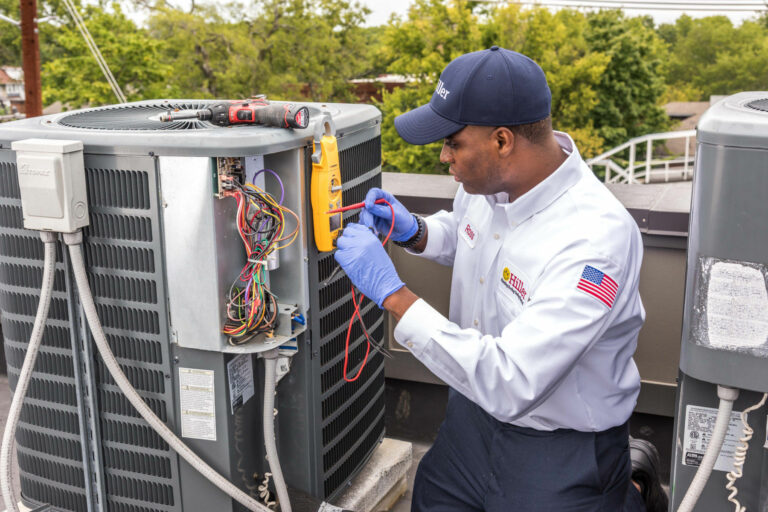The Ultimate Overview to Troubleshooting Common A/c and AC Concerns
Property owners typically come across numerous concerns, from insufficient cooling to bewildering noises originating from their systems. Acknowledging when a problem surpasses basic remedies can be equally crucial.
Common HVAC Troubles
Identifying typical HVAC issues is essential for preserving a comfy interior environment. House owners frequently come across concerns that can disrupt heating, ventilation, and air conditioning systems.
An additional constant issue is refrigerant leaks, which jeopardize the performance of cooling systems. Not enough refrigerant levels can cause systems to have a hard time in cooling down rooms, leading to greater operational expenses and prospective lasting damages. In addition, thermostat malfunctions can bring about inappropriate temperature regulation, causing discomfort and extreme energy usage.
Attending to these issues immediately is crucial to protect against additional damage and make certain ideal system performance. Normal upkeep and timely diagnosis of these typical Heating and cooling problems can substantially improve the reliability and performance of heating and cooling systems, inevitably contributing to a more comfy living atmosphere. air conditioner repair.

Indicators of Air Conditioner Issues
Recognizing the signs of cooling concerns is important for making sure ideal performance and comfort in your home. Among one of the most prompt indicators wants cooling; if your AC device is not giving the anticipated level of cooling, it might represent low refrigerant degrees, a stopping working compressor, or blocked filters. Additionally, if you see unusual noises-- such as grinding, screeching, or rattling-- this might suggest mechanical problems that call for prompt attention.
Another critical indicator is a boost in energy costs without an equivalent modification in use. This ineffectiveness frequently points to underlying concerns, such as dirt build-up in the coils or ductwork leakages. If you discover unpleasant odors rising from the unit, it can be a sign of mold and mildew growth or electric issues, both of which require immediate examination.
Lastly, constant cycling on and off, called short-cycling, can indicate problems with the thermostat or a poorly sized device. By being cautious concerning these indicators, you can deal with AC problems early, ensuring a comfy setting and extending the life of your cooling system.
Step-by-Step Troubleshooting
When your a/c system begins to underperform, it's important to damage down the troubleshooting procedure right into workable actions. Begin by checking the thermostat settings to guarantee it is established to the desired temperature and remains in cooling down mode. If the settings are right, inspect the air filter; a dirty useful site or stopped up filter can significantly hinder air flow and performance. Change it if necessary.
Following, check out the breaker or circuit box for stumbled breakers or blown merges. If the breaker has actually stumbled, reset it, yet watch on it; if it journeys once more, there might be a much deeper electric issue.
Examine the outside system for debris, such as leaves or dirt, which can obstruct air flow. Make sure the system is clear and that the fins are not bent.
Preventive Maintenance Tips

During these evaluations, service technicians can identify and deal with possible issues before they escalate. Additionally, replace air filters every 1-3 months to improve air top quality and system have a peek here performance.
Maintain the exterior device free from debris, such as leaves and dirt, which can hinder airflow. Trim surrounding plant life to keep a minimum of 2 feet of clearance (hvac). Check and clean the condensate drain to protect against water damage and mold development
Evaluate insulation around air ducts, ensuring it remains undamaged to avoid power loss. Take into consideration a programmable thermostat to enhance energy use according to your timetable.
Finally, monitor your system's performance routinely, keeping in mind any type of unusual sounds or modifications in temperature. Aggressive measures are necessary in preserving an efficient cooling and heating system, eventually resulting in reduced energy bills and boosted comfort.
When to Call a Professional
Understanding when to call a professional for cooling and heating problems can save you time, cash, and unnecessary stress. While some small issues might be solved through do it yourself troubleshooting, certain indicators show that experienced intervention is essential. If you experience inconsistent temperature levels throughout your home, unusual sounds from your HVAC system, or persistent odors, it is important to seek professional assistance.
In addition, if your unit stops working to begin or frequently cycles on and off, these might be signs and symptoms of more severe underlying issues that need specialized expertise and tools (HVAC Farmington MO). Refrigerant leakages, electric malfunctions, or problems with the compressor can make complex fixings and may present safety and security risks
One more critical element is the age of your system. If your cooling and heating unit is over 10 years old and displays repetitive problems, getting in touch with a professional for a complete evaluation can help identify whether repair service or substitute is more affordable. If you do not have the convenience or experience to manage intricate fixings, it's sensible to count on a certified technician.
Ultimately, prioritizing safety and efficiency is paramount. When doubtful, err on the side of caution and contact a specialist to ensure your a/c system runs ideally.
Final Thought
In verdict, efficiently repairing typical HVAC and Air conditioner problems calls for a methodical strategy to determine troubles, apply step-by-step options, and prioritize preventative maintenance. Acknowledging indicators of malfunction can stop minor problems from rising right into substantial repair work.